How To Calculate SCFM
**Standard cubic feet per meter (SCFM)** is one of several ways to formally describe the flow rate of gases. SCFM measures how much of the matter that makes up a gas (or mixture of gases) passes through a given region of space per unit time. This is in contrast to the simpler and more common measure, average cubic feet per meter **(ACFM)** in which the only variable of concern is simply the volume of gas flowing through a given region of space per unit time.
SCFM and ACFM both have units of volume per unit time. Ordinarily in physics, volumes are measured in cubic meters (m3) or some variation thereof, such as cubic centimeters (cm3, equivalent to milliliters or mL) and time is in seconds. In this case, both the volume (ft3) and time (min, or 60 s) units chosen to establish the basic flow rate unit are not SI (metric) units.
SCFM Meaning vs. ACFM Meaning
SCFM Meaning vs. ACFM Meaning
You may be familiar with the **ideal gas law,** which states that the pressure and volume of a gas are related in the following way:
\(PV = nRT\)
Where P = pressure, V = volume, n = the number of moles of gas present, R is a constant and T is temperature. Another way to express this is that if an ideal gas is subjected to a change, such that initial conditions are given the subscript 1 and final conditions the subscript 2:
\(\frac{P_1V_1}{T_1} = \frac{P_2V_2}{T_2}\)
In reality, the right-hand side of the ideal gas law has an additional variable Z, the gas compressibility factor. The upshot of all of this is that ACFM will always exceed SCFM by some amount, because adjustments to standard conditions in one variable cause compensatory changes in other variables. For example, compressing gases increases their pressure, while raising the temperature increases their product, even if not necessarily both variables simultaneously.
What is "Standard," Anyway?
What is "Standard," Anyway?
Ironically, there is no worldwide definition for what constitutes "standard" in this context. If you think "everyday comfortable conditions," that's probably very close to any of the typical numbers chosen for P, V and T.
The most commonly used values in the United States are scaled to "sea level" standard, since most of the heavily populated portions of the country are on the coasts or in relatively low-lying areas:
- 14.696 pounds per square inch (psia)
- 60 degrees Fahrenheit (°F), or about 15.56 °C
- 0 percent relative humidity (RH)
SCFM to ACFM Conversions
SCFM to ACFM Conversions
The formal equation for converting SCFM to ACFM usually takes the form of the following:
\(\text{ACFM} = \text{SCFM}\frac{P_{std}}{P_{act}-P_{sat}Φ}\frac{T_{act}}{T_{std}}\)
where
Pstd = standard absolute air pressure (psia), replacing P1 in the simplified relationship above; Pact = absolute pressure at the actual level (psia), replacing P2;
Psat = saturation pressure at the actual temperature (psi);
Φ = Relative humidity;
Tact = Actual ambient air temperature, the analog of T2; and
Tstd = Standard temperature, analogous to T1.
Remember, ACFM and SCFM are typically given in ft3/min, so be sure you are working with the right units when doing related calculations and conversions.
Compressed Air SCFM Calculator
Compressed Air SCFM Calculator
In the Resources, you'll find a tool that allows you to experiment with different levels of compression, pressure and temperature to see how SCFM relates to actual flow rate under a variety of conditions. You can also change the units to suit your needs, such as cubic meters per second (m3/s).
Cite This Article
MLA
Beck, Kevin. "How To Calculate SCFM" sciencing.com, https://www.sciencing.com/calculate-scfm-6716558/. 7 December 2019.
APA
Beck, Kevin. (2019, December 7). How To Calculate SCFM. sciencing.com. Retrieved from https://www.sciencing.com/calculate-scfm-6716558/
Chicago
Beck, Kevin. How To Calculate SCFM last modified March 24, 2022. https://www.sciencing.com/calculate-scfm-6716558/
